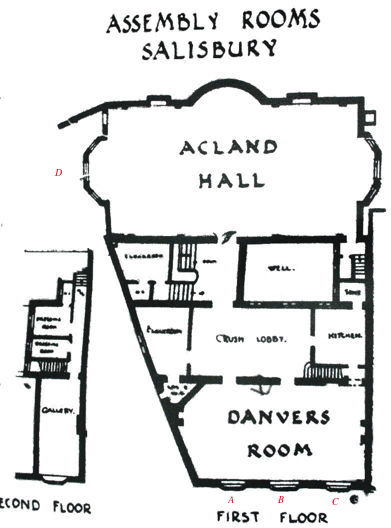
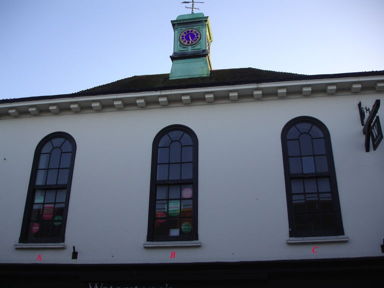
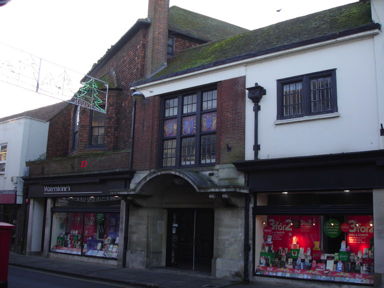
Plaque numbers 83 and 92 can be found at this location.
The plaque can be found on the side of Warterstones in the High Street.
The O/S grid position is SU nnnnn East nnnnn North.
Salisbury Civic Society
Formerly
SALISBURY ASSEMBLY ROOMS
1802-1960
7 High Street

After the political and social turmoil of the 17th century, the relatively calm environment of the 18th encouraged the growth of collaborative literary and musical events in many provincial English cities. Salisbury was no exception. Such events required venues, and there were assembly rooms in the city well before the date commemorated in this plaque. The 19th edition of James Easton’s Salisbury Guide, published in 1797, mentions: -
‘a concert every Thursday fortnight during the winter months, and once a month during the summer at which all strangers are admitted gratis: it is well supported, and has been established above 70 years. An Assembly held every other Thursday during the winter. The theatre is neat, and usually visited by a company of comedians every winter. The catch-club is held at the Spread Eagle every Tuesday fortnight during the winter. The races are commonly held during the month of August and continue 3 days: they are attended by a numerous and brilliant assemblage of company. In the evening of each day, there is a concert or ball at the assembly-room’.
The Victoria County History of Wiltshire mentions an annual autumn music festival in honour of St Cecilia. The festivals began in the mid 18th century and were held in the cathedral and the Assembly Rooms with the encouragement of James Harris, a philosopher, musical patron, librettist, friend of G.F. Handel, and resident of the Close. The festivals continued until 1787 (Harris having died in 1780), were revived in 1792, continued until 1796, lapsed until 1800, were revived again and held every 3 years until 1828.
It is clear from such enterprises that there was at least one assembly room in Salisbury in the 18th century. William Naish’s map of 1751 shows the ‘old assembly house’ in New Street, and a ‘new assembly room’ on the south side of New Canal near the current plaque site. Some time between 1751 and the publication of Donn’s map in 1797 the ‘old assembly house’ was demolished to make way for Alderman William Hussey’s hall (see plaque 73).
Haskins (the ancient trade guilds and companies of Salisbury, 1912) mentions an inn that ‘stood on the site of the present assembly rooms and known during the XVIII century as the Fountain Tavern. An Assembly Room, patronised by the best people for balls, concerts and dinners was attached to the Fountain’. Haskins includes a list of inn licenses granted during the 18th century showing the Fountain at No 57 New Canal (the site shown on Naish’s 1751 map as ‘the new assembly room’). The same list shows the Spread Eagle (mentioned in Easton’s guide) at Nos 53 and 55 ‘including the old Masonic Hall’.
In 1802 there were therefore already two ‘assembly rooms’ in use on, or next door to, the plaque site. What may have happened in that year is that an existing assembly suite was expanded. Certainly the Salisbury Journal for 1 November 1802 carried an advertisement inviting architects’ tenders for ‘plans for adding two new rooms, with convenient offices upon the same floor, and a proper stair-case (with two entries to it from the street) to the present assembly room at Salisbury (which assembly room is intended to remain) and for laying out the ground plot under the said rooms for shops, store houses etc’.
Whatever their origin, the new rooms soon became part of the musical and social scene in the city. The Salisbury Journal of 26 August 1804 said that ‘our triennial musical festival commenced on Wednesday evening at the New Rooms with a miscellaneous concert and ball’ adding later that ‘there never was a more lovely display of elegant and beautiful women than graced each ballnight at the Rooms, which presented a squeeze not to be surpassed at the splendid routes of the most fashionable in the British Empire.’
William Price Aylward, a piano teacher and music seller, organised subscription concerts and seems in the 19th century to have taken on the role assumed by James Harris a hundred years earlier. In Kelly’s Directory for 1880, he is shown as manager of the Rooms. The Victoria County History mentions a contraction in public entertainment in the mid century, but the Salisbury Journal continued to carry details of concerts in the Rooms. In 1840 Franz Liszt gave a recital, and there was a concert by the Viennese Ladies Orchestra. Tastes were refreshingly diverse - three concerts were given in 1847 by the Ethiopian Harmonists who performed on ‘the bones, banjo, tambourini and violin’ to the delight of the audience. Most significant of all in the city’s history was the public inquiry into sanitation held here, at the prompting of Dr Middleton, in June 1851 (see plaque 92). National events were also reflected. In August 1877 Commander Cheyne RN gave three illustrated talks, ‘musically accompanied’ and ‘illuminated by a very powerful oxy-hydrogen lime light’ on the polar search to find Sir John Franklin’s ill-fated expedition.
After 1900, the main use of the rooms seems to have been as a venue for dinners, dances, meetings whist drives and wedding receptions – not quite as glittering as the events of August 1804, perhaps, but still a significant part of the city’s life. The building was however showing signs of age. In 1924 WH Smith and Son acquired the site and started improvement work. On 16 October 1925 the Salisbury Times said: -
‘Since February in 1924 a very keen and friendly interest has been manifested in the process of transforming the old Assembly Rooms at the Corner of High Street and Canal from an ugly, antiquated and somewhat derelict and deserted structure into a smart and modern place of business and recreation. The whole of the extensive schedule of work is not yet completed, but it has gone so far that recently the ground floor has been opened by WH Smith and Son, the new proprietors, and the thoroughness and artistry of the change that has been effected is clear to all.’ The article goes on to say that ‘the outside will have been changed from something that possessed no artistic attraction into something which really fills up most satisfactorily and pleasingly a most important central corner of the city.’
On 1 January 1926 the Salisbury Times announced that work on the rooms was nearing completion and that they would soon be available for hire for 8 guineas per night for the Acland Hall and 4 guineas per night for the Danvers Room (see below). In March 1926 the WH Smith staff magazine (the Newsbasket) gave the following description of the Assembly Rooms as Smith’s had refurbished them: -
‘An entirely new venture on the part of the Firm was revealed to the public on Friday February 12th, when a concert was given in the Assembly Rooms, Salisbury. These rooms, which are situated over the new shop [i.e. Smith’s] comprise a handsome ballroom, known as the Acland Hall, and the Danvers Room, which is a smaller room eminently suitable for small dances and concerts; also a small Crush Hall and well-appointed cloakrooms, dressing rooms and kitchen.
The Acland Hall, with a floor space of 60 by 30, which has long been famous in the district for its acoustic properties, has been fitted with a spring floor, spot lights and coloured lighting effects, and this has been richly decorated in green, blue and gold with tapestried panels. Facing the handsome doorway is an alcove which has been effectively treated in decorative plaster, the motive being a Greek musical setting, which is greatly admired by visitors.
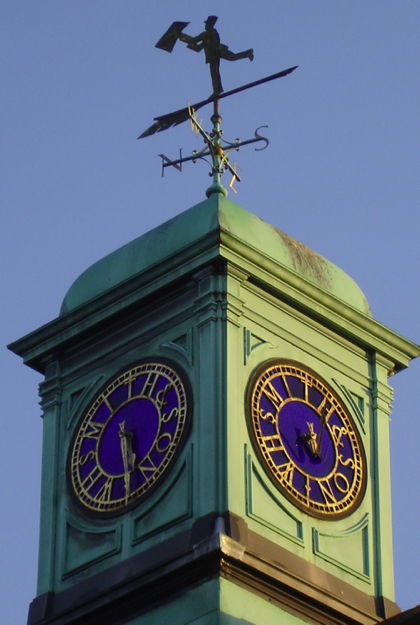
The Danvers Room, with a floor space of 34 by 22, is an oak panelled room. The Minstrel Gallery, access to which is gained behind the panelling, leaves an entirely clear floor for dancing etc.’
There then follows an item on a dance held at the rooms during which Councillor Rambridge ‘remarked upon the public spirit of the Firm in providing such handsome and comfortable rooms.’
Some of the features then added by Smith’s, such as the bow windows on the ground floor, have not survived. One notable survivor however is the cupola that now surmounts the building, with four clock faces bearing ‘WH Smith and Son’ in the place of figures and topped by a weather vane representing the WHS newsboy.
The Salisbury Times articles make it clear that Smith’s would manage the Rooms. However in the 1959 Kelly’s Directory they are listed as then under the management of Sutton’s Restaurant which was next door in the High Street. In 1960 the ownership of the restaurant changed hands and on 7 October of that year a letter appeared in the Salisbury Journal noting that the Rooms were about to close for public functions and arguing, following the abandonment of the City Hall project, that there were now too few public rooms available. The closure, the writer considered, was ‘another nail in the coffin of the cultural life of the city’. However, considering how big a part the Rooms had played in city life for over 100 years, and how many people must have had fond memories of them, there was remarkably little recorded public reaction to their closure.
WH Smith continued to occupy the ground floor and in 1965 modernised it (including removal of the bow windows). This was completed, said the Salisbury Journal on 5 December 1965, ‘just in time for Christmas’. WH Smith moved out of the building in 1994/95 and it is now occupied by Waterstones.
Below is the floor plan of the rooms as published by the Salisbury Times on 1 January 1926 where the Danvers Room overlooks the High Street. Alongside are views of the building today (2010) from the High Street side and from the New Canal side. The corresponding windows are indicated via the letters A.B.C.D.

|  |
 |
The Salisbury Guide 19th edition, 1797 – James Easton (via Google) pages 18-19
Royal Commission on Historical Monuments (England) report on Salisbury 1980
Kelly’s Directory for Salisbury 1880 and 1959
The Salisbury Journal – 1 Nov 1802, 26 Aug 1804, 7 Oct 1960, 5 Dec 1965
The Salisbury Times – 16 Oct 1925, 1 Jan 1926
The Newsbasket (WH Smith house journal) March 1926
William Naish’s 1751 map of the City of Salisbury (copy held by Salisbury reference library)
Donn’s 1797 map of Salisbury (in Salisbury Past by Ruth Newman and Jane Howells, Phillimore and Co 2001)
Goad’s plan of central Salisbury for 1994 and 1995 (copies held by Salisbury reference library
The Evanion catalogue - British Library, Evan.2624 (for details of Commander Cheyne’s 1877 lectures)
The ancient trade guilds and companies of Salisbury - Charles Haskins - Bennett 1912 (pages 315 and 355)
A History of the County of Wiltshire (the Victoria County History) Volume 6 edited by Elizabeth Crittal, 1962–pages 141-144 for details of music in 18th and 19th century Salisbury)
The Oxford Dictionary of National Biography article on James Harris by Rosemary Dunhill
Salisbury in focus – article by Eric Hicks in the March 1958 issue of the WH Smith staff magazine Newsbasket
Special thanks are due to Helen Taylor of the Wiltshire and Swindon history centre, to Hilary Hyde of the WH Smith Museum, Newtown, Powys and (as ever) the staff of the local studies library in Salisbury.
Dr Andrew Bogle Middleton MRCS
This plaque can be found at the corner of New Canal and High Street. It is on the New Canal side of Waterstone's building.
The O/S grid position is SU nnnnn East nnnnn North.
SALISBURY CIVIC SOCIETY
Andrew B Middleton MRCS
1819-1879
Eradicated cholera in Salisbury by
replacing open canals with drains and
covered sewers as recommended by
the Public Health Enquiry
held in this building 1851
Dr Andrew Bogle Middleton came from Shropshire to Salisbury and lived in the Cathedral Close where he married twice. During his time Salisbury was riddled, by design, with open drainage ditches. A good idea except they were not clean. They were filthy! The result was that diseases such as cholera could be spread quickly, and were. Dr Middleton realised that something had to be done about these open drainage ditches but there was fierce opposition from the mayor and councillors! Dr Middleton caused a public health inquiry to be held in Salisbury. The opposition denied the use of the Guildhall so the Salisbury assembly rooms were used for the enquiry in June 1851. The outcome was a recommendation to fill in the open channels and install tubular sewers. This was proceeded with over the forthcoming years. The last ditch to be filled in was the deep one running along the New Canal. Afterwards Dr Middleton’s statistics showed that Salisbury had become a healthier place.
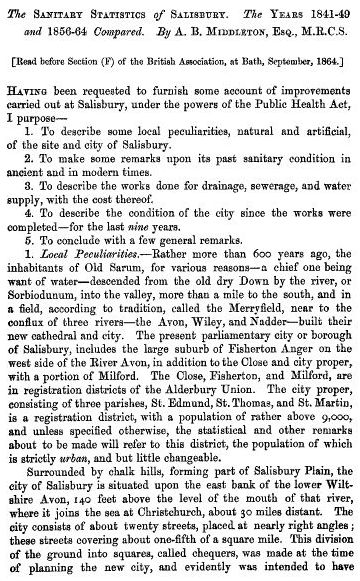
|
The SANITARY STATISTICS of SALISBURY. The YEARS 1841-49 and 1856-64 Compared. By A. B. MIDDLETON, Esq., M.R.C.S. [Read before Section (F) of the British Association, at Bath, September 1864]
Having been requested to furnish some account of improvements Surrounded by chalk hills, forming part of Salisbury Plain, the |
His statistics were even published in The New York Times of December 31st 1865! There is a large stained glass window in memory to him in the Cathedral. Thus Salisbury Civic Society decided that he was a notable Salisbury character who having achieved so much for the health of Salisbury, should be commemorated by a blue plaque.
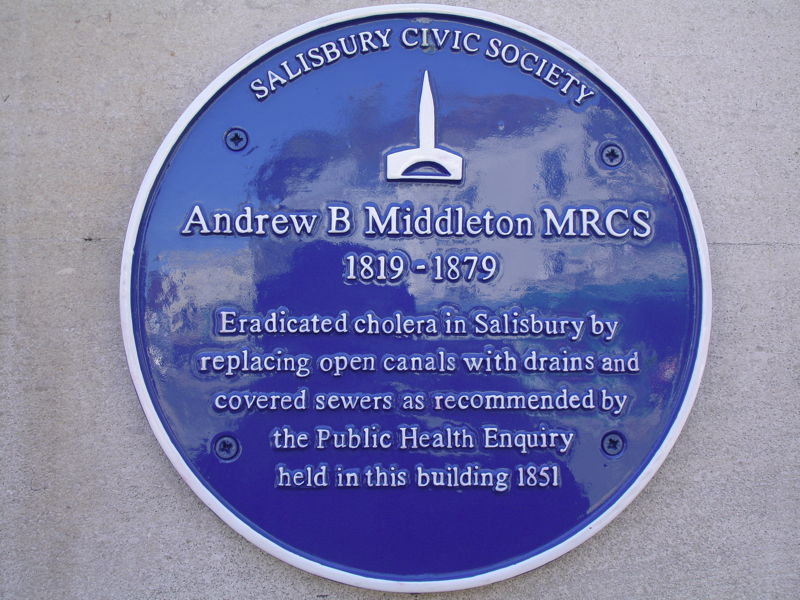
Salisbury Civic Society chairman Alastair Clark, president Dame Rosemary Spencer and deputy mayor John Abbott are shown in this photograph at the unveiling of Middleton's plaque on Thursday 17th June 2010.
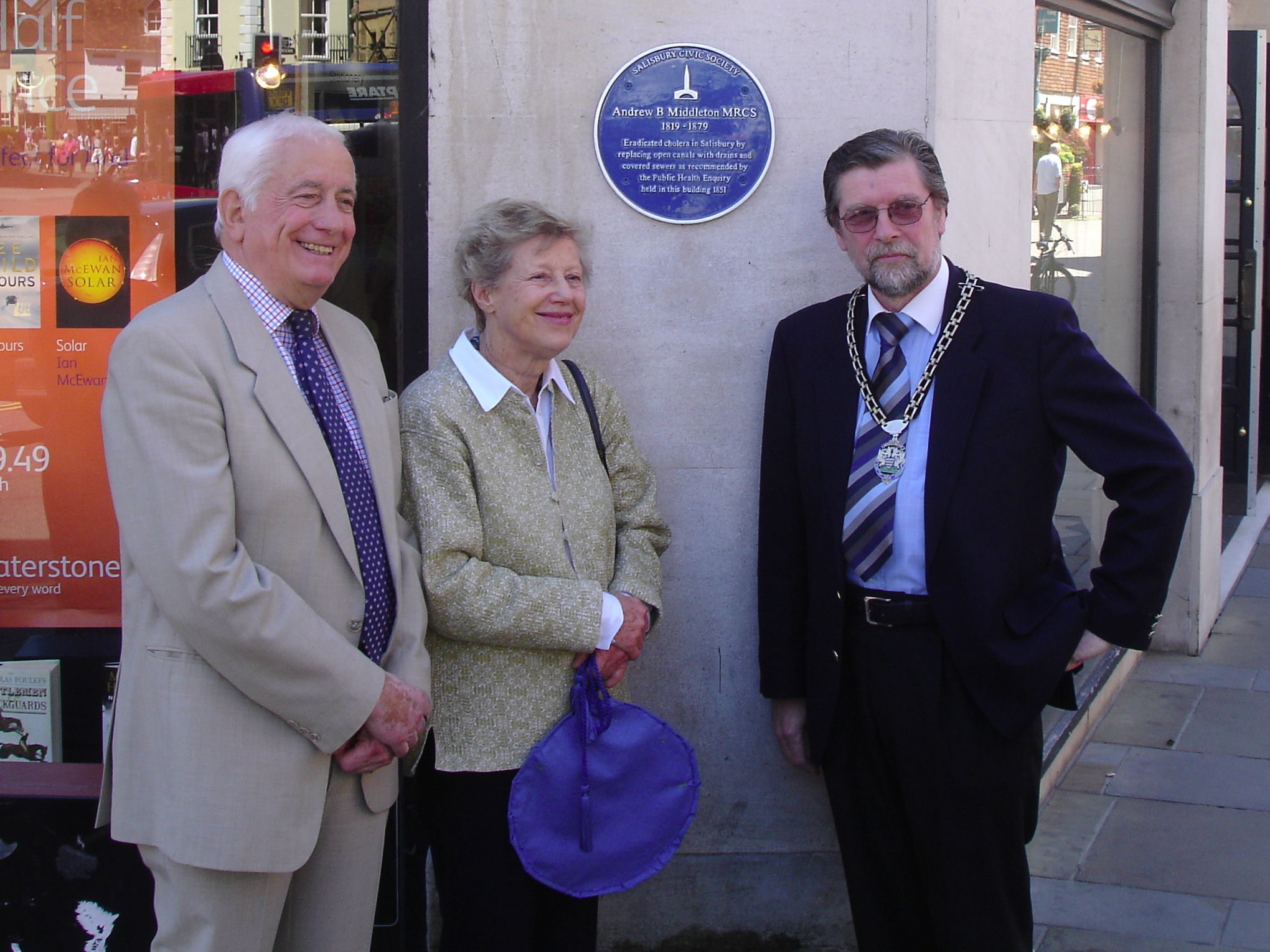
In 1849 nearly 200 people died of cholera in Salisbury in just two months. Salisbury was the worst affected town for its size in England and a noted cholera hotspot.
Dr Andrew Bogle Middleton (forthwith abbreviated to ABM) is credited with solving the cholera problem in Salisbury.
According to a book in the reference library on Salisbury's churches’ memorials, there is a low tomb memorial to a William Middleton, who died on 11th May 1851 aged 11, in St Martin’s churchyard. We have found no evidence of the cause of death of this young boy or whether he was related to Dr A B Middleton. Could his death have been related to cholera?
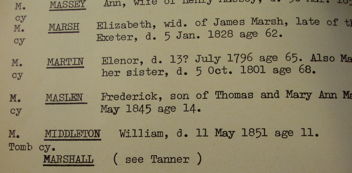
|
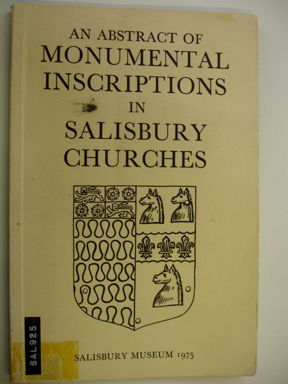
|
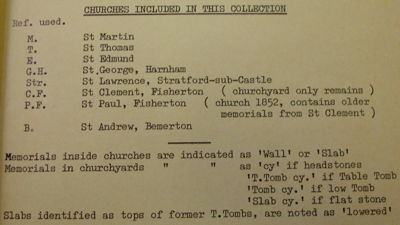
|
There is a Middleton Road in Salisbury. From a privately produced book of explanations of the names of roads/streets in Salisbury, to be found in the reference library, it states for Middleton Road - "hopefully this is named after Dr Andrew Middleton". There are three references: 4.5.1905 SC (Minutes of Salisbury City Council), 1912 D (Brown's Directory) and 1918 E (Electoral Register).
There is in Kelly's 1935 directory of Salisbury, page 188, concerning the Cathedral: "and a single lancet in the south transept to the late Mr Middleton was placed by his widow." The same words are also in the 1889 directory. A search in the Cathedral found the window, but in a different place. Is Kelly’s directory wrong? The Middleton window is on the east wall of the north transept, within the chapel of St Thomas and St Edmund.
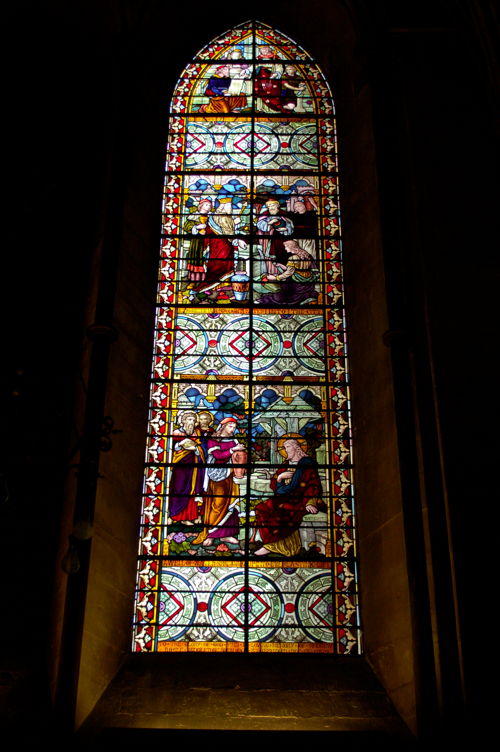
The theme is water; as you would expect in view of Dr Middleton's work. The upper panel shows King Hezekiah, who brought water into Jerusalem (II Chronicles chap 32 verse 30) while the lower shows Jesus meeting the Samaritan woman at the well at Sychar (St John ch 4). At the foot of the window is his name, Andrew Bogle Middleton, with his dates: born Oct 8th 1819, died Dec 13th 1879. It was then discovered that Sarah Brown's book, Richly and Sumptuously Adorned, says that the Middleton window was moved to its present site from the south transept in 1924. So Kelly was right, in 1889! She states that there is also a memorial to him and his wife in the north walk.
We found this memorial. It is about half way along the north wall of the cloister (by the tea tables) and reads: “In memory of Sarah Ann Louisa, wife of A B Middleton and daughter of the late Henry Coates of this City, died April 29 1872, aged 59 years and of the above Andrew Bogle Middleton who died Dec 13 1879 aged 60 years”
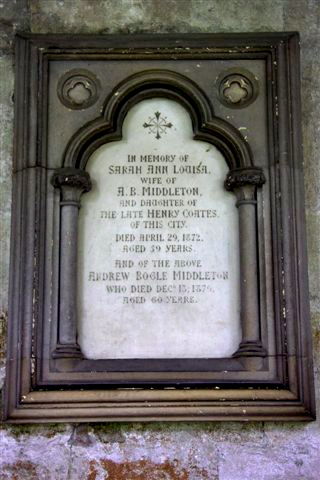
But how could his widow have placed a window to ABM if she had predeceased him? The answer lies in the fact that Middleton married Sarah Ann Louisa Coates (the daughter of a well known Salisbury medical doctor, Henry Coates) in 1849 but after her death in 1872 he married again in 1873 to Adelaide Stockwell in Woodstock, Oxford. She was living in the Close, as a surgeon’s widow, aged 49, with her brother and family in 1881 in either number 29 or 30. Enquiries to the manager of the Cathedral’s glaziers' department about the origins of the window did not elicit any more information than that in Sarah Brown's book. For example, the window was made by Ward & Hughes but their archives are reportedly lost.
Dr Andrew Bogle Middleton is such an unusual name that it can easily be found in the 1851, 1861 and 1871 censuses. It puts him as living in The Close in all three, but no further details. Be aware that his name is sometimes incorrectly transcribed from the census as Boyle.

The census has its own numbering system for dwellings, and using this, one of our researchers worked out that Middleton must have lived at either no 184/185 or Audley House, next door to the South Wilts museum. However, another puts Middleton between the Walton Canonry and Kings House, on the other side of the Museum (Kings House).
Subsequent to this, we found the following entry in the Royal Commission on Historic Monuments in England's book, Salisbury - Houses of the Close (HMSO 1993): “29 The Close - mainly a 14th century building with 19th century additions. Originally, an open hall stood to W. but in the 15th century the W part of it was separated off and in 1649 the small dwelling of a lay vicar stood there: it was demolished circa 1873 by the tenant A B Middleton.” Is this just after his first wife’s death?
The present no 29 is in the North Walk and some 200 yards from the sites which the two previous researchers had identified! Apparently Cyril Everett, who undertook a major study of the Close and its inhabitants, had ABM living “Betwixt Sherborne House and the Deanery... the Chantry house east of the Succentor's mansion” which would probably be the site now occupied by the modern buildings next to the South Wilts Museum. Middleton’s wife is not included in the 1851 census at his Close address. However the 1861 census does include his wife and where he was born; Hinstock, Shropshire, about 23 miles from the village of Middleton according to Google Earth.
Having failed to substantiate beyond all doubt where he lived in the Close, the Society decided to place the plaque on the New Canal side of Waterstones’ building. There is already a plaque on the High Street side, which you might not have ever noticed! More than one plaque on a building is not unusual; Salisbury library has quite a number of plaques on it! At least the Middleton plaque is on a different side. Perhaps, with two plaques quite close together, you will notice both.
Why place the Middleton's plaque on the wall of Waterstones where New Canal meets the High Street? Not only will a plaque here be seen by tourists making their way towards the Close, but this site also has several links to ABM. Waterstones occupies the former Assembly Rooms, and it was here in June 1851 that the Board of Health inspector held his inquiry, initiated through ABM's efforts, which recommended tubular sewers and a clean water supply after cholera had arrived in Salisbury in 1849. Apparently the mayor and councillors wouldn't let the inspector use the Guildhall! Also the deep channel in the New Canal was the last to be filled in, in 1875.
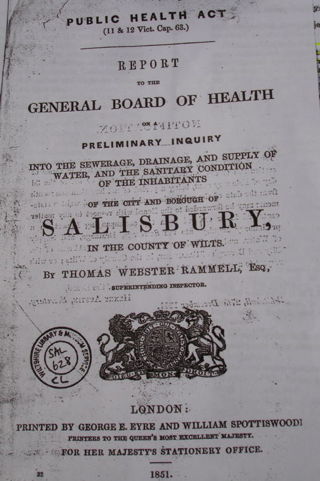
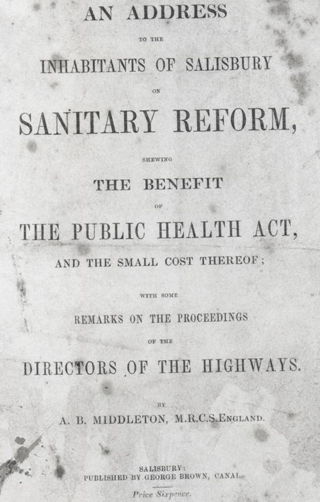
ABM destroyed Salisbury's reputation as 'The Venice of England', and in doing so saved hundreds of lives 'from untimely death'. He was an unpopular, dogmatic figure but worked for the good of the people and was the champion of public health reform in Salisbury. He was also behind the erection of the Market House (now the public library) opened in 1859.

|
OPENING OF THE NEW SALISBURY MARKET HOUSE AND MARKET RAILWAY. It is with very great pleasure that we this week record the successful completion of an undertaking which has, one might almost say, been a topic of discussion from time immemorial. If there has been one thing more than another about which a multiplicity of words has been expended it is upon the subject of erecting a market house for this city. As to the necessity for such an edifice there was no difference of opinion on the contrary upon this point, all was unanimity, but beyond it, at the time of the scheme which has now been carried out was propounded, scarcely two persons could be found who were agreed. Some were for having the building here, others there, and even if a satisfactory site could have be found, still we doubt not there would have been bones of contention as regards the particular structure needed. It may be interesting at this time briefly to refer to some of the numerous proposals which were brought forward and warmly advocated from time to time. First of all, then, there was one for the erection of a corn exchange on the ground up to the present time used as the corn market. There were many supporters of this scheme, not only in the Town Council, but even amongst the inhabitants, and more especially the farmers, and some expense was gone to in bringing Mr Tite, the eminent architect, here, who prepared plans and drawings, with the view of fixing upon this as the most favourable site it was said that could be selected. However, a strong feeling arose that the beauty of the Market-square, which is acknowledged by everyone to be the finest in the West of England, would be prejudiced by having it there; and, moreover, that it would almost entirely shut out from public view that handsome edifice, the Council Chamber. Tills site then, notwithstanding its having been recommended by Mr Tite in preference to two others, was thrown over. Another plan was to have the building in the centre of the Market-place, extending from Queen-street to Minster-street, with accommodation for stalls of every description, besides a corn exchange but the same objection applied to this as to the first-named that it would spoil the square. A third site suggested, and by far the most favourably entertained, was at the west end of the Council Chamber. The selection of this one would have necessitated the purchase of no less than six or seven distinct properties; and therefore the question of expense (it was stated by the committee appointed to report upon it that the purchase money and compensation to tenants would probably amount to £6000) as well as the interference it would cause to the cattle market, was urged against it, and so this scheme met with the same fate as the others. These, then were three out of some half-dozen or more places which were fixed upon, and when we add that it was intended to build by public subscription, and that one section of the inhabitants would not contribute a farthing if the building was to be erected in the Market-place, and another, if it were not, it will be readily seen that the prospect of obtaining a market house at all was becoming quite hopeless. It was after a stormy and fruitless public meeting had been held on the subject, and just at a time when everybody had resigned, all thoughts of ever hitting upon a project which would be likely to receive general support that a joint-stock plan was brought forward and so ably, clearly and argumentatively expounded that not a single word was publicly urged against it, although its promoter was most anxious for a challenged discussion. The scheme to which we allude is the one which has been carried out, and for which, as well as for the successful issue it has been brought to, the City of Salisbury is indebted to Mr A. B. Middleton, its projector. As our readers are already aware of the great advantages it possessed over all the others, particularly as regards the railway facilities it afforded, it is not necessary to recapitulate them; and we will therefore proceed at once to a brief description of the building before giving an outline of the interesting proceedings which took place at the inauguration. The edifice stands at the west end of the Market-place, on the site of the premises lately occupied by Mr. Prangley, Mr. Bennett and Mr. Toovey, fronting east, and extending back to the river Avon. Excepting the front, which is of stone, and has a very commanding appearance, it is built of white and red brick, and is entered by three spacious arched gateways. To meet all the varied requirements the building consists of a clear floor lighted with direct day lights through a roof chiefly composed of glass. The sides have stores over their entire length, capable of holding 2800 quarters of grain, and these stores or galleries are also lighted from the roof. The internal dimensions are front 73 feet, sides 168 feet, being almost the exact dimensions of Westminster Hall. The front central partition to be used as a corn exchange, is in extent 88 feet by 37 feet wide, or about 3000 square feet, and this space is calculated to accommodate 600 sample sacks. The back part of the central floor will be devoted to butchers and bacon factors, and the north side of the building to miscellaneous dealers. There is a large space behind Toovey’s house, which is accessible through a doorway in the north side wall, and this it is proposed shall be appropriated to greengrocers and dealers in butter, eggs and poultry. It has already been stated that one of the main recommendations of the project was that a railway should be made from the Great-Western and South-Western lines in Fisherton, to run completely into the Market-house. This has been done so far as regards the last named line, and a narrow and broad gauge line of rails laid down, so that cattle or merchandise sent by either of the four railways which run in to the city, can be brought right into the centre of the town, without the slightest trouble or inconvenience. With one detail more, namely that the capital authorised by the Company’s Act, to be raised in shares of £25 each for carrying out the undertaking, was £12,060, we pass on to THE INAUGURATION. Which was celebrated on Thursday last, by a public dinner, at 4 o’clock, and a grand concert in the evening. THE DINNER. Which was a cold one, took place in the left-hand gallery of the new building. It was supplied by Mr. Fielder, and embraced every delicacy. About 200 persons partook of this sumptuous repast. The chair was taken by J. H. Jacob, Esq., and the vice-chair by F. W. Gilbert, Esq. Amongst the company were the Right Hon. Sidney Herbert, M.P. Lord Henry Thynne, General Buckley, Mr H. Marsh, Esq., M.P., the Mayor, several of the borough magistrates and members of the Town Council, and many of the leading tradesmen of the city, and the principal yeoman of the neighbourhood. After the customary loyal toasts, the chairman proposed the “Army and Navy,” which was responded to by General Buckley and Captain Chambers. This was followed by the toasts of “The County Members,” acknowledged by Mr. Sidney Herbert and Lord Thynne: and “The Members of the City,” responded to by General Buckley and Mr. Marsh. The last named gentleman, in the course of his observations, pointed out the desirability of establishing manufactories in Salisbury, observing that coals could now be procured by railway, and that water-power existed in abundance. He expressed his intention of giving his active support to such a plan if it could be realised. The Chairman next proposed “The Mayor and Corporation of the city,” which was acknowledged by the Mayor. Mr Sidney Herbert proposed “Success to the Market-house Company,” coupling with the toast the name of Mr. A. B. Middleton, who in returning thanks read a long paper giving the history of the undertaking, and alluding in a very pointed manner to the opposition which it had encountered. The reading of the lengthy document was heard with much impatience by the company, who manifested their disapproval in a most unmistakable manner. Mr. Middleton having concluded the reading of his paper, Mr. John Lambert (one of her Majesty’s Poor-law Inspectors) in a very neat speech, proposed “The agriculturists of the neighbourhood,” dwelling on the great improvement which had of late years taken place in the vicinity of Salisbury, and expressing his gratification that, although he was no longer a resident in the city, a suitable market place had at length been provided for the accommodation of the buyers and sellers of agricultural produce. Shortly after this the company rose, and the tables were cleared, in order to make room for THE CONCERT. Which was afterwards held in the building, and drew together between 3000 and 4000 persons. The vocalists were Miss Banks, Miss Poole, Mr. G. Perreu. and Mr. L. W. Thomas; but the principal attraction was the celebrated band of the Royal Artillery, conducted by Mr. Smyth, the bandmaster of the regiment, in their full dress uniform. The programme contained an admirable selection of instrumental and vocal music, and loud plaudits were elicited from the audience during the performance. We have not space to enter into a long notice, and must therefore only express the gratification which was generally felt at the rich musical treat provided. The orchestra was erected at the east end of the Market House and was brilliantly lit with gas, as was also the entire building. |
|
If you visit Salisbury and South Wiltshire Museum you will find hung up high on one of the internal walls, the Market House clock donated by A.B.Middleton Esq. in 1860. If you haven't already, you can read all about A.B.Middleton's involvement in the Market House project in the previous web section. The clock was fixed to the balcony that ran around the sides and end of the building. All bar the Market House frontage was demolished in the late 1970's to make the new library. The clock is 62 inches high and 48 inches wide. The dial is a convex copper sheet. It is secured to the wooden frame of the clock. Access to the movement is from behind and hence there is no hole in the dial for a key or such. There are no makers' numbers or other identification marks. The pendulum, hidden by the clock face, is 21 inches long. Compare this with a seconds pendulum which would be 39.1 inches. |
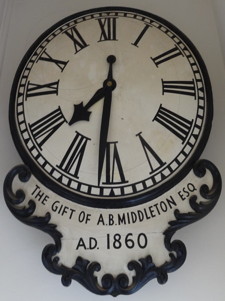
|
You can see the clock at the far end of this photograph of the interior of the Market House.
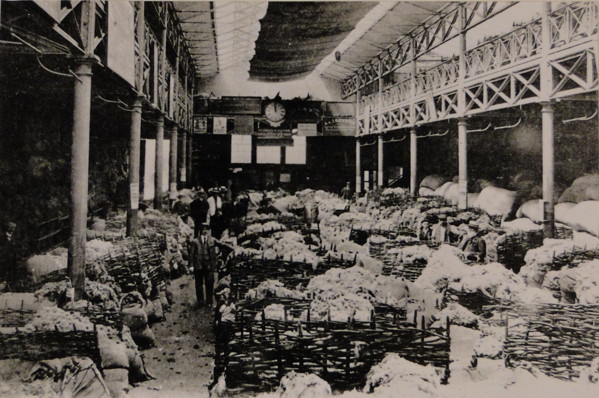
It is an indispensable condition of the sanitary reform which we hope to have introduced into our American cities that the public should become familiar with what can be done by sanitary science, and with what has been accomplished in foreign cities. The Health Bill which will be proposed during the approaching session of the Legislature, will, in all probability, (if it becomes a law,) produce in New-York and Brooklyn something of the same results which we observe from sanitary improvements in English cities -- the diminishing of the prevalent maladies of large cities -- the lengthening of human life and lessening the death-rate.
SALISBURY.
Most of my readers who have been in England will remember the picturesque town of Salisbury with its beautiful Cathedral. It happens to be important to sanitarians, as presenting one of the most marked instances in Great Britain of the effects of sanitary reform on the health of a community.
The city was distinguished in olden times by certain curious canals which flowed through the streets, and which even led the poetic mind, in a high flight of imagination, to compare Salisbury to Venice. Whatever this may have been in ancient times, in modern these canals had become very unwholesome and dirty ditches. They were made the receptacles of filth, and when full flooded the house drains and privies, thus sending their noxious gases through the streets and houses. There was also bad drainage, so that a wet subsoil always existed; cellars being wet and damp, and water even oozing over the floor of the Cathedral. Furthermore, there were quantities of cess-pools, which overflowed or drained through the ground into the wells, until the drinking water of the town became coloured and bad-smelling. So ignorant were the people of good water, that many of them quite enjoyed the taste of this, until analysis showed them that its color and taste were given in great part by human excrement. The results of all this were, naturally, that Salisbury was a very unhealthy place. There were five attacks of some terrible epidemic, called "the plague," in ninety years; in one of these attacks, one-fourth of all the inhabitants remaining perished; and from some statistics given in 1604, it is discovered that the death-rate was 46 in 1,000, or a little beyond the rate of the poor part of New-York.
Diarrhoea also prevailed; and in modern times, typhoid, scarlatina and consumption. To meet those evils, a scientific and philanthropic physician, Dr. A.B. MIDDLETON, attempted to introduce a new system of drainage and water-supply. He met with great opposition, but finally, in 1853, carried his plans through. These consisted of a thorough system of sewerage, the works consisting partly of brick mains, and partly of circular glazed earthenware pipes. The sewerage of one part of the town is conducted by an iron tube two feet in diameter, placed under the river Avon. In various parts flushing walls are placed at the corners of the streets, by means of which the pipes are flushed from the hydrants when necessary. Ventilation is secured by many of the rain-water pipes being connected with the house drains.
Pure water is obtained for the town by a well 68 feet deep, from which 500,000 gallons daily are pumped up by a pair of steam-engines. The cost of the whole works is £27,000; say $135,000. The changes effected in the appearance of the city are remarkable. "Instead of dirty canals," says Dr. MIDDLETON, "with dirty streets sloping toward them, the streets are now rounded in the centres and clean; the foot pavement equal to that of any town in England, instead of being uneven and full of holes. Neither the eye by day nor the nose by night is now offended as of old; the whole atmosphere is changed dry instead of moist, sweet instead of stinking; drainage and good sewerage and very dry subsoil in place of a saturated subsoil and had sewerages plentiful supply of good water available without labor in place of a bad supply of bad water with labor of pumping or of carrying from the channels. Dry underground cellars can now be made."
The subsoil water has been lowered four or five feet over the whole city, and the floor of the Cathedral is dry. Since drainage, in nine years, 531 less people have died than in nine years before drainage, excluding the cholera year; that is, instead of four, only three.
| Nine Years | Before Drainage | After Drainage |
| Births | 2,470 | 2,624 |
| Deaths | 2,226 | 1,695 |
| Majority of births | 244 | 929 |
The following table will show the total numbers of deaths in each of nine consecutive years before and after drainage. The years end upon the 30th of June, so that the cholera cases of 1849 are exclude:
| Year | Deaths before drainage | Year | Deaths since drainage | Decrease |
| 1841 | 230 | 1856 | 182 | 48 |
| 1842 | 268 | 1857 | 194 | 74 |
| 1843 | 284 | 1858 | 213 | 71 |
| 1844 | 251 | 1859 | 200 | 51 |
| 1845 | 216 | 1860 | 201 | 15 |
| 1846 | 200 | 1861 | 132 | 68 |
| 1847 | 321 | 1862 | 230 | 91 |
| 1848 | 220 | 1863 | 192 | 28 |
| 1849 | 236 | 1864 | 151 | 85 |
| Totals | 2226 | 1695 | 531 |
The average annual mortality before drainage was about 27 in 1,000; for the nine years since, 20 in 1,000. In other words, one-third of the deaths that would have occurred have been saved by these sanitary improvements; or, as Mr. CHADWICK somewhere expresses it, it is as if "one year in every three in Salisbury were a jubilee year -- entirely free from death." The character of the diseases, too, has changed.
Zymotic diseases killed 247 people in seven years before drainage, or 3.88 in 1,000 per annum, (cholera cases being excluded). In seven years since drainage, zymotic diseases killed only 172, or 2.73 in 1,000, as an annual average. The zymotic deaths in the whole kingdom being at the rate of 4.45 in 1,000 per annum, a comparison therewith is very much in favor of Salisbury. While 1 in 219 annually dies elsewhere, only 1 in 367 dies from that class of diseases in Salisbury. Of these zymotic diseases, typhus fever, which commits such ravages throughout the kingdom, can scarcely be said to have occurred as a cause of death in Salisbury -- in several years not at all. In the year 1862, out of 623 registration districts in England and Wales, only six were quite free from typhus; and of these, Salisbury was the only city; the others were small country districts. In seven years since drainage, 1857-63, only 12 cases of fatal eruptive fever have been registered, including typhus, typhoid and infantile; in seven years before drainage, 1844-50, of those diseases, 54 fatal cases occurred. As an annual average for all England, 1 in 1,071 of population dies from typhus and typhoid fevers. In Salisbury, only 1 in 5,262. Of diarrhoea, in the last seven years only 12 fatal cases have occurred, and of there 10 were children of under six months old.
In the seven years, diphtheria is mentioned only four times by itself, and twice in conjunction with other causes of death. Dentition produced 31 deaths in place of 60 in the former period of seven years. Since drainage, a great change has taken place in the number of deaths from the allied tubercular diseases, phthisis, tabes mesenterica, and hydrocephalus, as this table shows:
| Phthisis | Tabes Mesenterica | Hydrocephalus | |
| Before Drainage, 1844-50 | 286 | 32 | 30 |
| Since Drainage, 1857-63 | 143 | 17 | 10 |
| Diminution | 143 | 15 | 20 |
This diminution in a class of diseases admitted to be intimately connected with misty and moist atmosphere is remarkable. For comparison, a few facts as to the past and present general statistics of that scourge of England, consumption, may be interesting. In the beginning of this century one-fourth of the whole number of deaths was put down to it. INGLIS, in his book on the Channel islands, as lately as thirty years years ago, makes the following remark: "Of deaths from all causes, there die of phthisis in London, 25%; in France, 23%; at St. Petersburgh, 17%; at New-York, 17%. In Switzerland, Austria, Prussia and Belgium the mortality is not materially different from that in England, that is 25%, which seems to be its maximum mortality." Although doubtless obtained from the best available sources, these figures cannot be so accurate for England as those since obtainable from the Registrar-General's reports. One of those reports quoted in the Penny Cyclopedia in 1840 placed the proportion of phthisical deaths at 19.55%, or one-fifth of the whole number of deaths. This proportion during the last 20 years has much altered for the better, according to the Registrar's reports for some years past; about one-eighth instead of one-fifth of all the deaths are put down to phthisis. Some of this change may be owing to alteration of nomenclature and nicer discrimination in diagnosis. At Salisbury for the last seven years about one-tenth of the deaths have been from phthisis; for the last three years only one-thirteenth, and for the year 1863 only 11 occurred from phthisis, or 1 in 818 of population; the proportion for London having been 1 in 363, and for all England 1 in 374. The average age at which the 143 deaths from phthisis occurred during the last seven years, was 34.8 years. *
The Close of Salisbury shows, also, a reduction of death-rate from nearly 20 to about 14 in 1,000, which is lower than that of the Isle of Wight, which is about 17, and is one of the healthiest rates in the kingdom.
| TABLE OF COMPARATIVE MORTALITY FOR TEN YEARS | |
| . | In 1,000 per Annum |
| Isle of Wight | 17 |
| Clifton | 21 |
| Scarborough | 21 |
| Bath | 22 |
| England | 22 |
| Brighton | 22 |
| Canterbury | 23 |
| Worcester | 23 |
| London | 23 |
| One hundred and forty-two Districts including chief Cities | 24 |
| Exeter | 24 |
| York | 24 |
| Southampton | 24 |
| Bristol | 27 |
| Birmingham | 27 |
| Manchester | 31 |
| Liverpool | 33 |
| FOR NINE YEARS | before drainage | since drainage |
| City of Salisbury | 27 | 20 |
| Close of Salisbury | 20 | 14 |
Macclesfield is also a marked instance of the effects of sanitary improvements. In this town great numbers of houses have been whitewashed and cleaned annually by the authorities. Those who build new ones are required to submit their plans for approval to the Local Board of Health (an excellent provision, by the way, to imitate here.) Nuisances have been removed, and an expensive system of draining and paving was undertaken, which in 1854 included twenty-four streets and ninety courts and passages. With this was enforced a general sanitary reform in draining privies, cleaning yards and ash-pits, and the like.
The results are very plain. In the seven years ending September, 1848, the rate of mortality in the borough was 33 in 1,000. In five years since 1848, and ending September, 1853, before the works were fairly in operation, the mortality was 29 in 1,000. In 1854 the mortality was 25.
But the most marked effects were in the worst streets -- streets corresponding in character to those of the Fourth and Sixth Wards in New-York. The average stands thus, after the sanitary improvements:
| % less deaths | |
| Wood-street | 60% |
| Nixon's yard | 42% |
| Watercotes | 40% |
| Wellington-street | 34% |
| Water-street | 12% |
The latter streets were the last completed. The average length of life in Macclesfield, up to 1848, was 24 years; in 1854, it was 27 years. The decrease of deaths of persons between 20 and 30 years was 23% that is nearly a quarter of the young men and women of the town who would have died were saved by sanitary science. The saving, too, in sickness, has been very remarkable. Thus in Wood-street the relief-books of the Board of Guardians show 24% less sickness; in Nixon's yard, Wellington-street and Water-street, 29% less; while in the poor streets near by, not paved and sewered, there is no decrease.
Under good sanitary arrangements crime, too, diminishes.
| % less crime | |
| Wood-street | 55% |
| Nixon's yard | 17% |
| Water-street | 24% |
as shown by the police records.
Mr. RAWLINSON, in a report upon the borough, shows the expense in poor-rates saved by sanitary improvements. He takes certain poor streets which were sewered and paved:
| Relief paid in 1845 | Relief paid in 1855 | |
| Wood-street | £54/0/0 | £3/18/0 |
| George-street | £54/0/0 | £12/10/3 |
| Water-street | £40/4/6 | £1/0/0 |
| Nixon's Yard | £10/1/0 | £7/16/6 |
| Total | £158/5/6 | £25/4/9 |
The cost of all the works in the streets was £1,541. The saving of one year in poor rates (£133/0/9) paid the interest (£77/1/0) on the outlay at 5% and left £56 as an instalment toward the principal.
Another saving is estimated from the number of deaths. The rate of mortality being reduced 7 in 1,000, it is estimated that during five years 1,015 lives were saved. In funeral expenses alone, calculated from 232 burial clubs, £8,729 were saved.
There have been also in that period 28,420 less cases of sickness, and estimating the cost according to the data furnished by benefit societies at a shilling a day for 20 days, £28,420 would have been saved in this way alone.
The deaths of children under one year have also decreased 16.3% and those under five years, 4.6% †
C.L.B. NEW-YORK, Tuesday, Dec. 26, 1865.
* The Benefits of Sanitary Reform as shown at Salisbury. By A.B. MIDDLETON.
† Reports of the Macclesfield Board of Health.
Click here to go back to Salisbury Plaques Home Page
Click here to go to the Salisbury Civic Society's Home Page.
Click here to check validation.